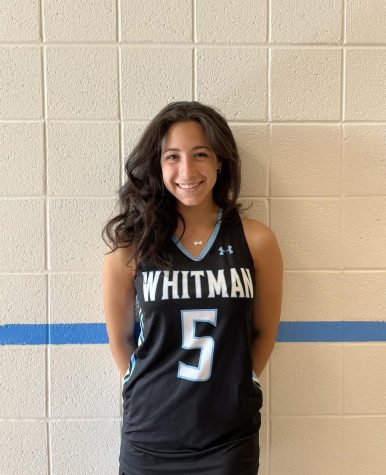Navigating friendly waters: students find unity on the Whitman sailing team
The Whitman sailing team racing on the Anacostia River during practice.
May 4, 2022
A slight breeze sweeps gently through the air as the Whitman sailing team walks down the barnacle-studded dock towards the Anacostia River. The athletes will start practice soon, but instead of school sports jerseys, they suit up in life jackets and dry suits — waterproof, full-body uniforms that keep sailors dry. With the arcs of the Frederick Douglass Memorial Bridge on the horizon, the sailors are ready for another splendid day on the water.
The Whitman sailing team, affiliated with the sailing school DC Sail, meets every Monday and Thursday at the docks by Nationals Park from late February through May. The eight students on the Whitman team gather at the marina alongside students from other local high schools to make up a 32 person team.
Whitman captain Grace Corbett, a senior, believes that the DC Sail team members shared interest in sailing allows them to connect despite coming from different schools.
“These are people I would’ve never been able to meet otherwise because they’re from all over the DMV,” Corbett said. “Everyone shares the same passion that I do for this sport that’s uncommon, which makes us closer.”
A typical DC Sail practice includes drills like playing “follow the leader,” forming straight lines and turning quickly around a buoy. Even before these exercises, though, the sailors prepare their boats for the river — no simple feat.
The team sails Flying Juniors, 13’3” racing boats that each require two sailors: one skipper who commands the mainsail; and one crew, who controls the smaller sail and instructs the skipper. Before each duo pushes their boat into the water, the racers attach the tiller — the part of the boat that allows the skipper to steer — into the tail end of their craft. The team continues by “raising the jib,” or raising the smaller of the two sails; then, they hoist the mainsail. Finally, they tie coiled barrel and figure-eight knots into the mast’s ropes, securing the rigging so there isn’t slack in the sail. One of the sailors then firmly pushes the boats away from the dock and into the Anacostia River.
As each boat glides farther from shore, their sails catch the wind and sailors determine how to balance the boat accordingly. Once they have established a steady rhythm, sailors participate in exercises, which are dependent on daily wind levels.
For junior Will Kessner, a surprise greeted him on his first day of practice this season. High winds caused eight boats to capsize, hurling his fellow sailors into the river.
“Two kids got water in their dry suits. They were freezing and everyone was trying to help them,” Kessner said. “We’re always just trying to help each other out and have a good time.”
Once a boat is on the water, each sailor depends on their partner to complete their respective tasks; anything short of total trust can lead to injuries or boat damage. Whenever freezing water laps on the sides of the boat and soaks the occupants, for example, the crew has to lunge over the side of the boat and rely on the skipper to complete an even turn.
“I aspire to be someone my team can depend on, as both a skipper and crew,” Corbett said.
On the DC Sail team, sailors compete in monthly regattas during the season. Regattas are typically in Annapolis, which requires the team to wake up at 6 a.m. on the mornings of the events. The team competes against 17 other boats. Shortly before each competition, DC Sail gets out on the water to figure out the day’s wind patterns and the ideal maneuvering tactics, which allows them to begin the race at full speed.
The regatta includes a course to sail through, but unlike in other sports, not all boats start at the same position. That’s because even before the whistle blows, the clock starts ticking: the sailors have three minutes to get as close to the starting line as possible. Once the race officially begins, the boats avoid hitting other crafts and try to maintain their right-of-way in order to be the first to pass the finish line, marked by a colorful flag.
While the prospect of competing in these regattas enticed sophomore Phoebe Milhollin, her family ties to the water initially attracted her to the sport, she said.
“My grandfather was in the navy, so I went sailing as a kid and went to a few summer camps for it,” Milhollin said. “I was really excited when I heard that Whitman had a sailing team.”
Junior Finn van Riper is also no stranger to the pastime: he’s been sailing since the third grade. Since he previously could only sail during the summer, he enjoys competing in the Whitman season because it enables him to participate in his favorite activity, he said.
“There’s barely any chances to sail competitively, and Whitman sailing provides the amazing opportunity of sailing during the school year,” Van Riper said. “I don’t mind if we win or lose the regattas. I’m just happy I can sail.”
Whitman’s sailing team provides students with the opportunity to explore a unique activity that most high schools don’t offer, and it also allows participants to experience a collaborative and familial environment, Corbett said.
“I think it’s crucial [for Whitman] to offer diverse sports, because I tried virtually every activity and never found something that I truly loved until I started sailing,” Corbett said. “Without sailing, my life wouldn’t be the same.”
Grace Corbett is an outgoing social media director for The Black & White.











